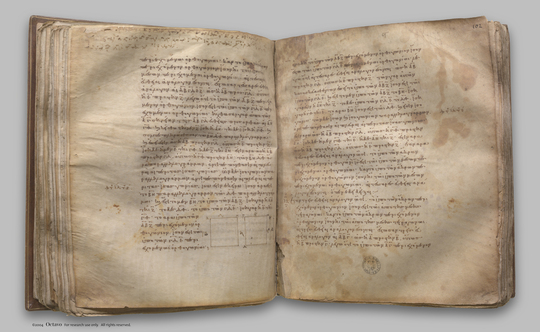index prev next | digilib folio 106

Let the three straight lines A, B, C be proportional, so that, as A is to B, so is B to C; I say that the rectangle contained by A, C is equal to the square on B.
| Ἐὰν τρεῖς εὐθεῖαι ἀνάλογον ὦσιν, τὸ ὑπὸ τῶν ἄκρων περιεχόμενον ὀρθογώνιον ἴσον ἐστὶ τῷ ἀπὸ τῆς μέσης τετραγώνῳ: κἂν τὸ ὑπὸ τῶν ἄκρων περιεχόμενον ὀρθογώνιον ἴσον ᾖ τῷ ἀπὸ τῆς μέσης τετραγώνῳ, αἱ τρεῖς εὐθεῖαι ἀνάλογον ἔσονται. Ἔστωσαν τρεῖς εὐθεῖαι ἀνάλογον αἱ Α, Β, Γ, ὡς ἡ Α πρὸς τὴν Β, οὕτως ἡ Β πρὸς τὴν Γ: λέγω, ὅτι τὸ ὑπὸ τῶν Α, Γ περιεχόμενον ὀρθογώνιον ἴσον ἐστὶ τῷ ἀπὸ τῆς Β τετραγώνῳ. Κείσθω τῇ Β ἴση ἡ Δ. Καὶ ἐπεί ἐστιν ὡς ἡ Α πρὸς τὴν Β, οὕτως ἡ Β πρὸς τὴν Γ, ἴση δὲ ἡ Β τῇ Δ, ἔστιν ἄρα ὡς ἡ Α πρὸς τὴν Β, ἡ Δ πρὸς τὴν Γ. ἐὰν δὲ τέσσαρες εὐθεῖαι ἀνάλογον ὦσιν, τὸ ὑπὸ τῶν ἄκρων περιεχόμενον [ ὀρθογώνιον ] ἴσον ἐστὶ τῷ ὑπὸ τῶν μέσων περιεχομένῳ ὀρθογωνίῳ. τὸ ἄρα ὑπὸ τῶν Α, Γ ἴσον ἐστὶ τῷ ὑπὸ τῶν Β, Δ. ἀλλὰ τὸ ὑπὸ τῶν Β, Δ τὸ ἀπὸ τῆς Β ἐστιν: ἴση γὰρ ἡ Β τῇ Δ: τὸ ἄρα ὑπὸ τῶν Α, Γ περιεχόμενον ὀρθογώνιον ἴσον ἐστὶ τῷ ἀπὸ τῆς Β τετραγώνῳ. Ἀλλὰ δὴ τὸ ὑπὸ τῶν Α, Γ ἴσον ἔστω τῷ ἀπὸ τῆς Β: λέγω, ὅτι ἐστὶν ὡς ἡ Α πρὸς τὴν Β, οὕτως ἡ Β πρὸς τὴν Γ. Τῶν γὰρ αὐτῶν κατασκευασθέντων, ἐπεὶ τὸ ὑπὸ τῶν Α, Γ ἴσον ἐστὶ τῷ ἀπὸ τῆς Β, ἀλλὰ τὸ ἀπὸ τῆς Β τὸ ὑπὸ τῶν Β, Δ ἐστιν: ἴση γὰρ ἡ Β τῇ Δ: τὸ ἄρα ὑπὸ τῶν Α, Γ ἴσον ἐστὶ τῷ ὑπὸ τῶν Β, Δ. ἐὰν δὲ τὸ ὑπὸ τῶν ἄκρων ἴσον ᾖ τῷ ὑπὸ τῶν μέσων, αἱ τέσσαρες εὐθεῖαι ἀνάλογόν εἰσιν. ἔστιν ἄρα ὡς ἡ Α πρὸς τὴν Β, οὕτως ἡ Δ πρὸς τὴν Γ. ἴση δὲ ἡ Β τῇ Δ: ὡς ἄρα ἡ Α πρὸς τὴν Β, οὕτως ἡ Β πρὸς τὴν Γ. Ἐὰν ἄρα τρεῖς εὐθεῖαι ἀνάλογον ὦσιν, τὸ ὑπὸ τῶν ἄκρων περιεχόμενον ὀρθογώνιον ἴσον ἐστὶ τῷ ἀπὸ τῆς μέσης τετραγώνῳ: κἂν τὸ ὑπὸ τῶν ἄκρων περιεχόμενον ὀρθογώνιον ἴσον ᾖ τῷ ἀπὸ τῆς μέσης τετραγώνῳ, αἱ τρεῖς εὐθεῖαι ἀνάλογον ἔσονται: ὅπερ ἔδει δεῖξαι. | Let the three straight lines A, B, C be proportional, so that, as A is to B, so is B to C; I say that the rectangle contained by A, C is equal to the square on B. Let D be made equal to B. Then, since, as A is to B, so is B to C, and B is equal to D, therefore, as A is to B, so is D to C. But, if four straight lines be proportional, the rectangle contained by the extremes is equal to the rectangle contained by the means. [VI. 16] Therefore the rectangle A, C is equal to the rectangle B, D. But the rectangle B, D is the square on B, for B is equal to D; therefore the rectangle contained by A, C is equal to the square on B. Next, let the rectangle A, C be equal to the square on B; I say that, as A is to B, so is B to C. For, with the same construction, since the rectangle A, C is equal to the square on B, while the square on B is the rectangle B, D, for B is equal to D, therefore the rectangle A, C is equal to the rectangle B, D. But, if the rectangle contained by the extremes be equal to that contained by the means, the four straight lines are proportional. [VI. 16] Therefore, as A is to B, so is D to C. But B is equal to D; therefore, as A is to B, so is B to C. |